The Tarusa raspberry tree is the very first and already quite popular variety among gardeners and summer residents, bred as a result of breeding work. This famous berry crop has many advantages and has its own characteristics. When growing Tarusa raspberries, you need to know and strictly follow all the rules for planting and caring for them.Only a responsible approach to these issues will lead to a good harvest. This article provides detailed information about the variety, its advantages, methods of propagation and nuances of care.
|
This is what the Tarusa raspberry bush looks like |
| Content:
|
Description of the variety
Professor and Doctor of Science, famous breeder and bold experimenter Viktor Valerianovich Kichin, together with his colleagues, was able to make a real discovery in gardening in the late nineties. It is based on the “large fruit gene”, thanks to which an unusual variety of large-fruited raspberries appeared. Tarusa raspberry is the result of crossing the summer varieties Shtambovy 1 and Stolichnaya.
|
After proper formation of the crown, the crop takes the form of a tree. |
A compact variety with mid-early ripening and an attractive appearance. Each plant can produce six to ten stems. The height of straight, strong and elastic shoots depends on the local climate and can vary from one hundred and twenty to one hundred and fifty centimeters. The average shoot diameter is about two centimeters. Each of them is covered with light pubescence and a slight waxy coating.
In the first years after planting, the crops produce almost no shoots. In the future, its quantity will increase due to the growth of the root system.
Video describing the Tarusa raspberry variety:
In early June, the bushes are covered with large white flowers with a diameter of about one and a half centimeters. In July, Tarusa begins to bear fruit.The berries, elongated in shape, differ from other varieties in their large size: weight - from six to twelve (sometimes up to fifteen) grams, width - up to two and a half centimeters, length - up to three and a half centimeters. The pulp is dense, the juiciness is medium, the taste is slightly sour. The seeds in the fruits are practically not felt, they are very small. The aroma of raspberries is rich and persistent. The yield from one bush is more than four kilograms.
Features and Benefits
- The variety produces consistently high yields that are easy to transport and store. Thanks to the dense pulp, the berries remain intact during transportation and do not leak.
- Tough and strong shoots are distinguished by the absence of thorns; they easily hold the crop and do not require additional support. The fruits are easy and convenient to collect.
- The fruiting period extends from mid-summer to early September.
- Crops with an already formed crown do not take up much space on the site; they are compact and highly decorative.
- The variety is a record holder for winter hardiness, as it tolerates even thirty-degree frosts. It is suitable for growing in different climatic conditions. In regions with snowless winters, plants must be covered already at minus twenty-five degrees.
- Strong immunity makes the crop immune to many diseases and resistant to various pests.
- Features of care include the love of raspberries for drip irrigation and organic fertilizing, mulching of the root area and loose soil.
Application
Tarusa raspberries are universal in use. In summer you can enjoy fresh berries. They make delicious desserts, smoothies, fruit and berry salads. The fruits can be frozen and dried.They are suitable for jam and jam, compote and juice, jelly and liqueurs. The berries are added to tea and used in baking. The fruits and leaves are incredibly useful for colds, intestinal problems and weak immunity.
Planting and caring for Tarusa raspberries
Landing dates
The survival rate of seedlings in a new location depends on the correct timing of planting. Tarusa can be planted in early spring (around mid-March or early April), when all the snow has melted, or in the fall - in the first half of September. More precise dates are determined taking into account the climatic conditions of each region.
Autumn planting of Tarusa raspberries:
Selecting a location
The raspberry tree prefers bright, open areas with minimal drafts and gusts of wind. Soil moisture should be moderate, so it is better to choose small hills or build embankments. The optimal depth of groundwater is at least one hundred and fifty centimeters. You can plant berry plants around the perimeter - along the fences. But there should be no tall trees or buildings nearby.
Important! Although raspberries are a moisture-loving crop, they absolutely cannot tolerate stagnant water and wetlands.
The composition of the soil must be nutritious and maximally enriched with useful elements, and the structure must be loose and breathable. Sandy and loamy areas with low acidity levels are suitable.
It is recommended to place Tarusa away from beds with some vegetable and berry crops: strawberries, wild strawberries, tomatoes, potatoes.
Reference! In southern regions, plants will require light shade, especially during the midday hours.
Soil preparation
If the acidity level of the soil in the area is high, then before planting, add a lime solution (about eight hundred grams per square meter). It is also important to properly feed the soil. To do this, for each meter of area you will need: one faceted glass of wood ash, one hundred and fifty grams of complex mineral fertilizers, and about two large buckets of rotted humus. In clayey areas, it is recommended to add peat.
|
After planting, seedlings must be watered well |
The depth of the landing pit is about fifty centimeters, the width is sixty. The interval between plantings is one meter, between rows - at least one and a half meters.
Landing technology
Immediately before planting, compost, sawdust, wood ash or a solution of bird droppings are added to each hole and watered. The seedling is placed in the center, sprinkled with earth, compacted around the trunk, and watered abundantly. After this, all shoots are cut off, leaving about thirty centimeters above the ground, and a mulching layer of peat, sunflower husk or humus is applied around the seedlings.
Attention! In the first three to four days, young plants must be shaded from the scorching sun.
Features of care
Watering rules
Tarusa is a moisture-loving variety that needs regular moderate watering. Experienced gardeners recommend using various methods and techniques of moistening:
- drip irrigation;
- watering through furrows constructed next to the crops;
- sprinkling.
|
Drought and excess moisture are equally dangerous for Tarusa. |
Berry crops must be watered in a timely manner and in the correct amounts.At the stage of leaf formation and during flowering, bushes need from five to seven liters of water, and at the stage of ovary formation and during fruiting, each adult tree needs one and a half to two buckets of irrigation water. The frequency of moistening depends on weather conditions and soil conditions.
Caring for standard raspberries in early spring:
Application of fertilizers and fertilizers
To get a good harvest, it is impossible to do without fertilizing. Organic and mineral fertilizers must be applied regularly and competently, in strictly specified volumes and at certain stages of development of the raspberry tree.
On a note! Before applying fertilizing, it is necessary to weed the raspberry trees in the rows and between the rows, then loosen the soil and moisten it abundantly. Fertilizers cannot be applied to dry soil.
In early spring, two and a half to three liters of solution (of fifty grams of urea and ten liters of water) and a glass of ash are added under each tree. You can use ammonium nitrate at the rate of ten grams per square meter.
|
In the second half of May or at the beginning of the summer season, raspberries are fed with mullein infusion prepared from a bucket of water and five hundred milliliters of mullein. Five liters will be enough for each meter section. |
At the beginning of autumn, you can apply dry fertilizers. Granulated superphosphate and potassium salt, wood ash or humus are scattered around each tree.
How to care for the Tarusa raspberry tree:
Shaping and pruning a raspberry tree
This procedure not only improves the appearance of the crop and makes picking berries more convenient, but also strengthens the health of the raspberry tree and helps increase productivity.
The first pruning is carried out when the height of the main stem reaches a meter mark.It is recommended to shorten it by about ten to fifteen centimeters. This haircut will lead to the formation and development of side branches.
|
Formation of a raspberry tree |
During the summer months, the tops of these growing side shoots are pinched to form a beautiful spherical crown. It is also advisable to get rid of excess root shoots. Only the most powerful and healthy should be left.
Autumn pruning is a mandatory procedure. It is recommended to cut off lignified two-year-old shoots at the root, while young annual shoots should only be shortened. It is necessary to leave the height no more than one hundred thirty to one hundred and fifty centimeters. After pruning, six to seven of the strongest and strongest branches should remain on the bush, all the rest should be removed.
Reproduction of Tarusa raspberries
Root cuttings
This method raspberry propagation used only in autumn. An adult raspberry tree must be carefully dug up, roots with buds selected, and cuttings cut at least ten centimeters long.
Important! Each cutting should have two (or at least one) healthy buds. You cannot take more than three to four cuttings from one adult plant.
In warm southern climates, prepared cuttings can be immediately planted in the ground to a depth of five centimeters, moisten the soil generously and cover with transparent plastic film until sprouts appear. It is possible to store cuttings until spring in planting boxes with a sand-peat mixture (the proportions of peat and river sand are 1 to 1) in a cool room with a temperature from zero to plus four degrees. The seedlings are transferred to a permanent place in the second half of April.
|
Propagation by shoots is the simplest method, which is most often used by gardeners. |
Overgrowth
Shoots are practically ready-made seedlings, so this method is more popular among gardeners. The side shoots growing from the roots are carefully dug up, separated from the mother plant, and immediately planted in a new area. Each root shoot must have part of the root and healthy buds. It should be free of signs of diseases and pests, the average diameter is eight millimeters.
Don't forget to read:
Other varieties of raspberry trees with descriptions and reviews ⇒
Preparing for winter
Preparing a raspberry tree for wintering is a whole complex of mandatory procedures and measures - pruning, fertilizing, preventive treatment, and constructing a shelter.
- All unnecessary and useless shoots, as well as diseased, damaged and non-viable shoots, and the tops of two-year-old and older branches must be pruned.
- After fruiting has ended, depleted soil is fed with fertilizers containing potassium, phosphorus and ammonium sulfate (about two hundred and fifty grams of product per meter of area).
- It is recommended to spray raspberry crops with disinfecting solutions as a preventive measure against diseases and pests. You can use a solution of iron sulfate.
- In cold regions with a lot of snow, bushes are covered with it, and in other areas you can use fallen leaves. The optimal layer of foliage is thirty centimeters and above.
Attention! In the northern regions, where frosts drop below thirty degrees, bushes need to be covered in early October. Before frost arrives, the branches bend well and are easy to fix at a height of thirty to forty centimeters from the ground. In the central and southern regions, raspberries will not need shelter.
Preparing standard raspberries for wintering:
Do not miss:
Diseases and pests
The Tarusa variety is highly resistant to pests and most diseases, but in rare cases such problems may arise.
A possible disease of the raspberry tree is chlorosis. It develops due to insufficient or excessive watering, as well as a lack of certain nutrients in the soil. Yellow or light green spots appear on the leaves, and productivity decreases. To restore normal life, it is important to normalize the watering and fertilizing regime.
The most common pest of raspberries is aphids. It spreads very quickly along the branches and sucks the juice out of them, which leads to drying out of the leaf blades. To get rid of this scourge, it is necessary to tear off damaged leaves or completely cut off the tops of infected shoots.
In the absence of preventive measures, raspberry beetles, weevils or raspberry moths may appear in the raspberry plant. Pests can be destroyed using chemicals (for example, the drug BI 58) or folk methods and means. For these purposes, use garlic or pepper infusion, tobacco powder and other proven recipes.
Do not miss:
There are several mandatory agricultural practices that will ensure that diseases and pests never disturb Tarusa.
- Regularly in early spring and autumn you need to completely rid the raspberry tree of plant residues.
- Infected and cut shoots should be burned away from the garden.
- During the warm season, it is important to loosen and weed the soil in a timely manner.
- In the fall, it is necessary to carry out deep digging of row spacing.
- To repel pests, use calendula, tansy and even ordinary dill as neighbor plants.
Reviews from forums about Tarusa raspberries
Oleg S.
“The yield is high, the berries are large, but the taste is not very good. We propagate by root suckers. It produces a lot of offspring (maybe because the soil is good). The variety is more marketable, the berry is transportable, but somewhat bland.
But the possibility of growing without a garter is exaggerated - during the ripening of the berries, the shoots bend even with a slight wind.”
Marina A.
“In fact, popular rumor, as often happens, somewhat exaggerates: Tarusa raspberries can be considered a tree with a very big stretch, they are just bushes, the berries on which grow on top, and not throughout the bush... These berries are the most common in taste, well, maybe a little sweeter than regular raspberries. And yet, even this small difference in this variety makes it very popular among gardeners today!”
Alexandra K.
“I couldn’t be happier with my Tarusa. The bushes are really bowing from the abundance of harvest. It ripens on my site around July 5th. It doesn’t leak for a very long time and is very tasty, we only keep this variety for ourselves as a late one. Very productive, transportable. I don’t plan to change it even in the distant future, they don’t look for good from good.”
Ivan, 42 years old, Tver
“Last year I bought seedlings of this raspberry, tempted by advertising. At first it was interesting to form standard bushes. It worked, but I'm still disappointed. The seller promised something exceptional both in terms of yield and taste, but it turned out that everything was very mediocre. I was pleased that a garter is not needed, there are no thorns, and few extra shoots are formed, but this, by and large, is all the advantages.Now there are varieties so tasty and prolific that it is not a pity to tie them up and thin them out for the sake of the harvest. This one has large berries, but the taste is not at all impressive.”
Irina, 58 years old, Moscow region
“I planted Tarusa raspberries for testing (a friend gave me a couple of rooted cuttings). I didn’t start forming “trees”, although I knew they were doing it. I was more interested in such properties as the possibility of growing without support and the weak “spreading” of shoots. I planted them like regular raspberries (3 shoots per bush), watered them, mulched them, and lightly fed them. The bushes were not sick, there were quite a lot of berries. The taste did not seem the brightest, but the berries were ripened large and dense, so easy to freeze. In the fall, I cut out the fruit-bearing trunks and shortened the young ones. I was too lazy to bend them down (they were too thick), and in vain: almost all the tops were caught in the frost. Now the bushes have come to life and are blooming. I hope there will be a harvest."
Diana V.
“We have been growing Tarusa for a long time; my father planted the first sprouts when I was a schoolgirl. Now there are about six varieties of raspberries at the dacha, but Tarusa stands out very favorably for its large and beautiful berries with a wonderful aroma.”
Oleg S.
«My Tarusa is frozen this year, perhaps due to winds with severe frosts in non-snowy areas. There was a harvest, but it was weak; the berries were large, but tasteless and forked. I haven’t decided yet - maybe they will delete it.”
Nikolay K.
“The variety is very productive. Not small at all, all large. The color of the berry is original, raspberry. The shape of the berries is ideal and beautiful. The berry does not crumble, the drupes are firmly attached. Does not crumble when overripe. There are no bifurcated ones. Doesn't taste great. The vitamins from it are excellent. Until the ovary stands like a tree, the shoot is as straight as a fence.But when the ovary begins to fill up - the head of the bush falls under the weight - it needs to be tied up. It doesn't produce much growth. The shoots are thornless. I haven’t seen any diseases, the most problem-free variety. Frost resistance is excellent, it has never frozen.”
You might be interested in:
- Planting and caring for raspberries in open ground
- Garden blackberries: planting and care in open ground, photo
- The best varieties of black raspberries with descriptions and reviews from gardeners
- The best varieties of yellow raspberries with descriptions, photos and reviews
- Raspberry tree Fairy Tale: description, photo, rules of planting and care
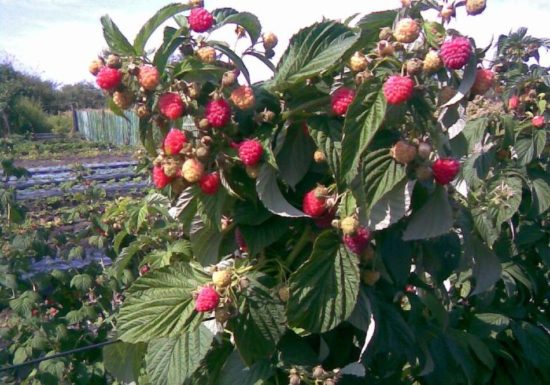
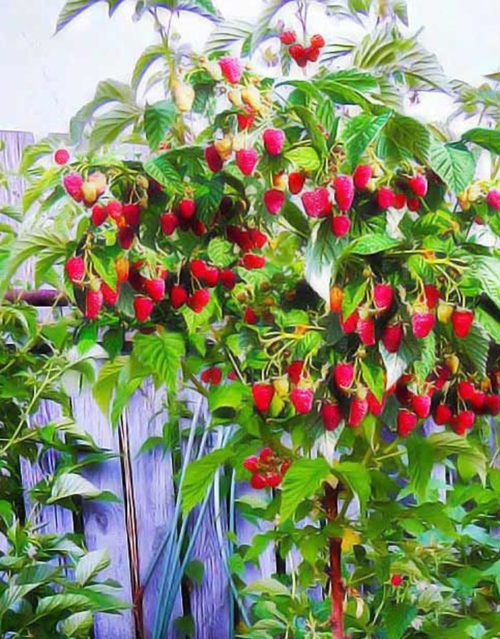
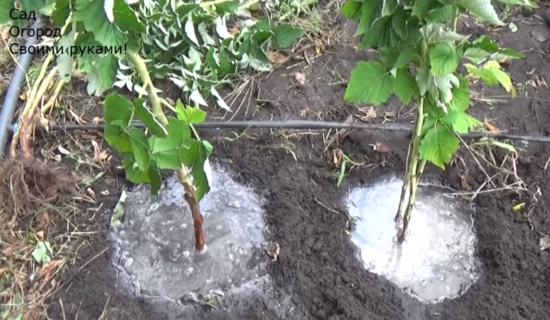
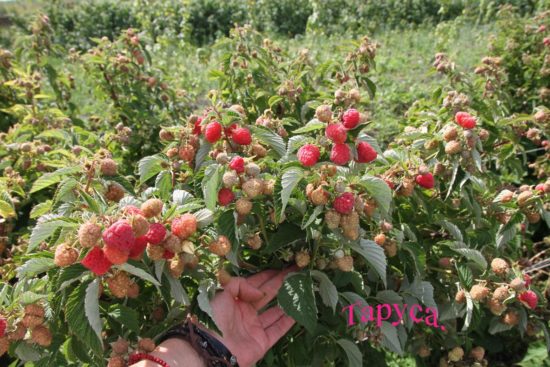
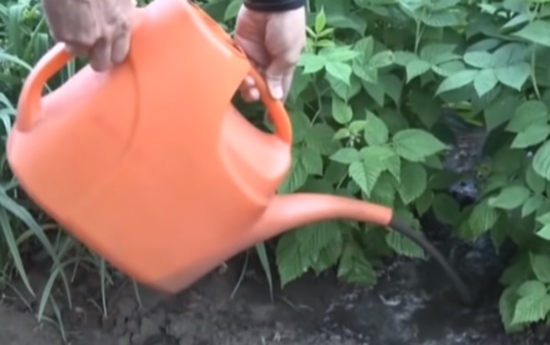
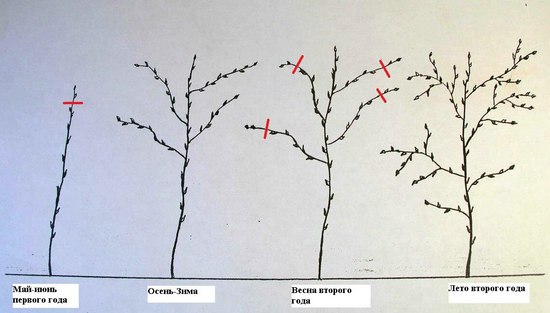
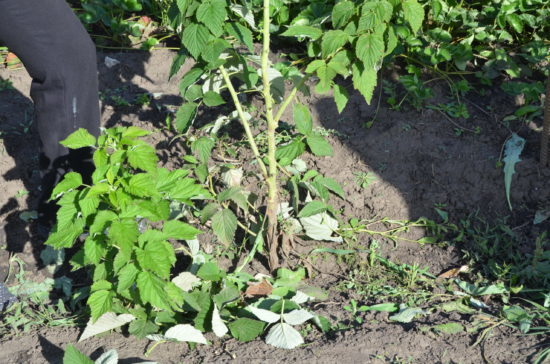

 CUCUMBERS NEVER GET SICK, I'VE BEEN USING ONLY THIS FOR 40 YEARS! I SHARE A SECRET WITH YOU, CUCUMBERS ARE LIKE THE PICTURE!
CUCUMBERS NEVER GET SICK, I'VE BEEN USING ONLY THIS FOR 40 YEARS! I SHARE A SECRET WITH YOU, CUCUMBERS ARE LIKE THE PICTURE! You can dig a bucket of potatoes from each bush. Do you think these are fairy tales? Watch the video
You can dig a bucket of potatoes from each bush. Do you think these are fairy tales? Watch the video
 How our fellow gardeners work in Korea. There is a lot to learn and just fun to watch.
How our fellow gardeners work in Korea. There is a lot to learn and just fun to watch. Eye trainer. The author claims that with daily viewing, vision is restored. They don't charge money for views.
Eye trainer. The author claims that with daily viewing, vision is restored. They don't charge money for views. A 3-ingredient cake recipe in 30 minutes is better than Napoleon. Simple and very tasty.
A 3-ingredient cake recipe in 30 minutes is better than Napoleon. Simple and very tasty. Therapeutic exercises for cervical osteochondrosis.A complete set of exercises.
Therapeutic exercises for cervical osteochondrosis.A complete set of exercises. Which indoor plants match your zodiac sign?
Which indoor plants match your zodiac sign? What about them? Excursion to German dachas.
What about them? Excursion to German dachas.